
Safety Tip: Electrical Safety Best Practices

Three electrocutions in mines prompted the Mine Safety and Health Administration (MSHA) to issue a “Safety Alert” featuring tips to help prevent electricity-related accidents. Even if you don’t work in a mine, these tips can help prevent electrocution:
- Do not perform any electrical work until the circuit is de-energized, locked and tagged out.
- Be knowledgeable of the hazards of electricity and NEVER touch any ungrounded electrical component until you are sure it is de-energized.
- Identify all hazards then develop and follow a safe plan to perform the work to ensure the safety of all miners who are involved in the task. Conduct electrical measurements to test for unwanted electrical power, especially in wet or muddy areas.
Always handle de-energized cables instead of energized cable, or wear proper electrical gloves when handling energized cables. - Conduct complete and thorough examinations on all electrical equipment, including hand-over-hand examinations of de-energized electrical cables.
- Protect electrical cables from damage by mobile equipment. When cable damage is suspected, immediately notify a qualified electrician.
Electrical Troubleshooting Best Practices:
- Develop, communicate, ensure understanding and execute a plan before performing electrical troubleshooting or electrical work to ensure maximum safety for all workers involved.
- When troubleshooting can be performed without power, always de-energize the circuit.
- Never troubleshoot energized high-voltage circuits (over 1,000 volts).
- Wear properly rated and well-maintained electrical gloves when troubleshooting or testing energized low- and medium-voltage circuits.
- Ensure electrical meters and non-contact voltage testers are properly rated and in good operating condition
- After determining the electrical problem – and before performing electrical work – open the circuit breaker, disconnect and lock-out and tag-out the visual disconnecting device. Ground high-voltage circuits.
Electrical Work Best Practices:
- After determining the electrical problem, and before performing electrical work, open the circuit breaker, disconnect and lock-out and tag-out the visual disconnecting device. High voltage circuits must also be grounded.
- Perform your own lock-out and tag-out procedure and NEVER rely on others to do this for you. Multiple locks for multiple workers
- Use electrical meters and non-contact voltage testers to ensure electrical circuits are de-energized prior to performing electrical work.
- Prior to energizing equipment that has not been in service for an extended period of time, take great care to examine and test components, especially safety devices, to ensure that the equipment is in safe operating condition. Consider the service life of each component.
Remember: When you break the plane of an open enclosure, compartment or panel you ARE DOING electrical troubleshooting or electrical work! Before taking gloves off, turn off the power.

